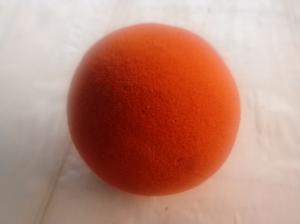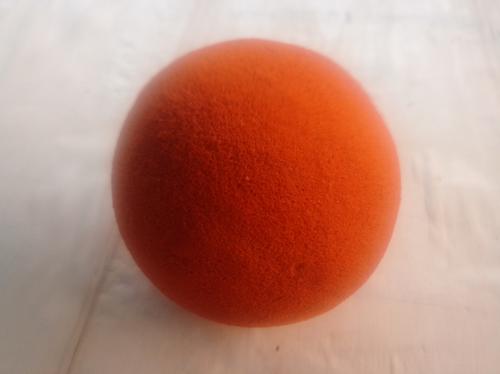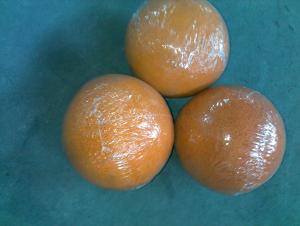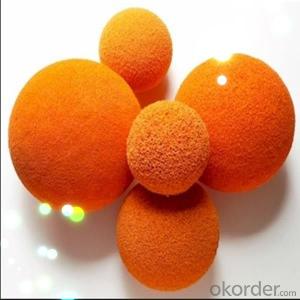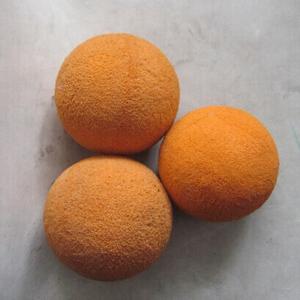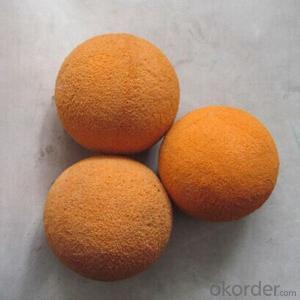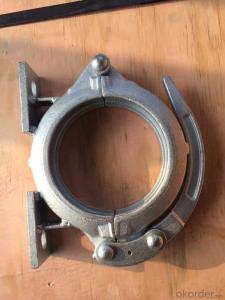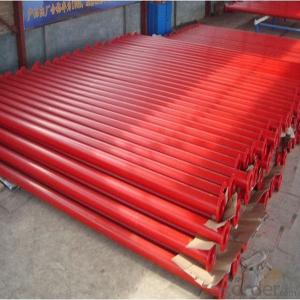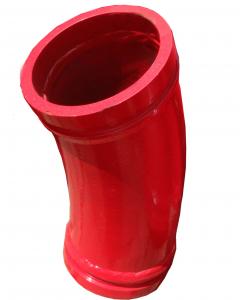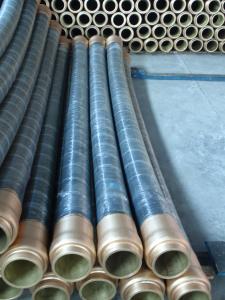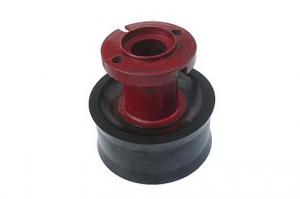Concrete pump sponge ball
- Loading Port:
- Tianjin
- Payment Terms:
- TT or LC
- Min Order Qty:
- -
- Supply Capability:
- -
OKorder Service Pledge
Quality Product, Order Online Tracking, Timely Delivery
OKorder Financial Service
Credit Rating, Credit Services, Credit Purchasing
You Might Also Like
CONCRETE PUMP CLEANING SPONGE BALL
- SIZE 6"
- SOFT, MEDIUM SOFT, HARD
- DIA. 150MM OR 160MM
- WEIGHT: 438-443G (+/-3%)
- GENERAL USE FOR CONCRETE MIXER & PUMP
- MATERIAL: RUBBER
- PROCESS: FORMED RUBER AND GROUND
- PLACE OF ORIGIN: CHINA OR TAIWAN
- CONCRETE PIPE CLEANING BALLS
OTHER SIZE FOR REFERENCE:
5.5" CLEANING BALL
- Q: Are there any specific guidelines for the installation of hydraulic filters or strainers in concrete pump spare parts?
- Yes, there are specific guidelines for the installation of hydraulic filters or strainers in concrete pump spare parts. These guidelines typically include ensuring proper alignment, securely fastening the filter/strainer, and following manufacturer instructions for installation. Additionally, regular maintenance and inspection of the filters/strainers is recommended to ensure optimal performance and prevent potential issues.
- Q: Can I get spare parts for both concrete pumps with and without remote control systems?
- Yes, it is possible to get spare parts for both concrete pumps with and without remote control systems. Many manufacturers and suppliers of construction equipment offer spare parts for various models and types of concrete pumps. Whether your pump has a remote control system or not, you can typically find replacement parts such as valves, cylinders, hoses, pistons, and other components from reputable suppliers. It is important to ensure that you provide the correct specifications and model details when ordering spare parts to ensure compatibility with your specific concrete pump.
- Q: How often do I need to replace concrete pump spare parts?
- The frequency at which you need to replace concrete pump spare parts depends on various factors such as the quality of the parts, the usage intensity of the pump, and the maintenance practices followed. Generally, high-quality concrete pump spare parts can last for a longer time and may not require frequent replacements. However, if the pump is used extensively or in demanding conditions, the spare parts may wear out more quickly. To ensure the optimal performance and longevity of the concrete pump, it is essential to adhere to a regular maintenance schedule. This includes inspecting the spare parts for any signs of wear and tear, monitoring their performance, and replacing them as needed. It is advisable to consult the manufacturer's guidelines or seek professional advice to determine the specific replacement intervals for your concrete pump's spare parts. Keep in mind that neglecting proper maintenance or using low-quality spare parts can lead to more frequent replacements, which can be costly and disrupt your construction projects. Therefore, investing in high-quality spare parts and following a diligent maintenance routine will help maximize the lifespan of your concrete pump and minimize the frequency of replacements.
- Q: Are there any specific guidelines for the transportation of concrete pump spare parts?
- Concrete pump spare parts have specific guidelines for transportation to ensure their safe arrival and immediate usability. Consider the following key guidelines: 1. Packaging: Adequate packaging is necessary to prevent damage during transportation. This may involve using sturdy boxes, crates, or pallets to protect parts from impacts and vibrations. 2. Labeling: Clearly label each package with its contents, including the specific part name and number. This facilitates easy identification and prevents confusion during transportation. 3. Handling: Handle spare parts with care to avoid mishandling or dropping, which could cause damage. It is recommended to use proper lifting equipment and follow safe handling practices to prevent excessive stress or force. 4. Securing: Properly secure packages to prevent movement or shifting during transportation. This can be achieved by using strapping, shrink-wrapping, or other suitable methods to keep packages in place. 5. Temperature control: If spare parts are temperature-sensitive, ensure proper temperature control during transportation. Extreme temperature variations can damage certain parts, so it's important to protect them accordingly. 6. Transportation mode: Select suitable transportation modes based on the size and weight of spare parts. For larger parts, flatbed trucks or specialized vehicles may be necessary to accommodate their size and weight. 7. Insurance: It's advisable to have proper insurance coverage for the transportation of concrete pump spare parts. This provides financial protection in case of unforeseen incidents or damages during transit. By adhering to these guidelines, concrete pump spare parts can be transported smoothly and safely, guaranteeing their intact delivery and immediate usability.
- Q: Is the main pump of the concrete pump electric control or hydraulic control?
- The main pump behind the oil pump to provide the size of the oil with the greater the current the higher the higher the higher the displacement,
- Q: What are the safety measures to consider while replacing concrete pump spare parts?
- To ensure the safety of workers and the successful replacement process of concrete pump spare parts, it is important to consider several safety measures. Firstly, before beginning any maintenance or replacement work, it is crucial to adhere to proper lockout/tagout procedures. This involves disconnecting the equipment from its power source and using lockout devices to prevent accidental startup. This ensures that the equipment cannot be operated while replacement work is being carried out. Secondly, workers involved in the replacement process should wear the appropriate personal protective equipment (PPE). This includes safety goggles, gloves, hard hats, and steel-toed boots to protect against potential hazards such as flying debris, falling objects, or accidental contact with sharp edges. Additionally, prior to starting the replacement, a thorough inspection of the equipment should be conducted to identify any potential hazards or defects. This includes checking for damaged or worn-out parts, loose connections, or any signs of deterioration. If any issues are found, they should be resolved or repaired before proceeding with the replacement. Furthermore, proper lifting techniques must be utilized to prevent musculoskeletal injuries. Concrete pump spare parts can be heavy and bulky, so workers should be trained on lifting techniques and should use mechanical aids like cranes, hoists, or forklifts when necessary. When dealing with heavy or awkwardly shaped parts, team lifting should be employed. Moreover, the work area should be secured to prevent unauthorized access and ensure the safety of workers. This can be done by using barricades or caution tape to cordon off the area and provide warnings to others about the ongoing replacement work. Adequate lighting should also be provided for clear visibility. Using the right tools and equipment is crucial for safe and efficient replacement work. Workers should be trained on the proper use of tools and ensure that they are in good working condition. Using damaged or faulty tools can lead to accidents or improper installation of the spare parts. Lastly, it is important to follow the manufacturer's instructions and guidelines for replacing concrete pump spare parts. This includes understanding the correct sequence of steps, torque requirements, and any special precautions that need to be taken. Deviating from the manufacturer's instructions can compromise the safety and performance of the equipment. By implementing these safety measures, the risk of accidents, injuries, or equipment damage can be minimized during the replacement of concrete pump spare parts. Safety should always be prioritized, and all workers involved should be properly trained and equipped to carry out the replacement work.
- Q: What is the function of a concrete pump hopper grate clamp?
- A concrete pump hopper grate clamp serves the purpose of securing the hopper grate on a concrete pump. This device ensures that the hopper grate remains fixed in position, preventing the entry of large debris and foreign objects into the pump system. The clamp is specifically designed to tightly hold the hopper grate, guaranteeing its stability during the pumping process. Its role is to preserve the integrity of the pump system and avert any potential damage or blockages caused by unwanted materials. In summary, a concrete pump hopper grate clamp functions as a dependable and secure method to maintain the hopper grate in place, facilitating efficient and seamless concrete pumping operations.
- Q: What is the purpose of a concrete pump cylinder?
- The purpose of a concrete pump cylinder is to provide the necessary pressure and force to transport and deliver concrete from the pump to the desired location. The cylinder is an essential component of a concrete pump, as it allows for the efficient movement of concrete through the pump system. The cylinder works by using hydraulic pressure to push the concrete through the pipeline, ensuring a continuous and smooth flow of concrete. It plays a crucial role in construction projects, enabling concrete to be precisely and efficiently placed in various locations, such as buildings, bridges, or other structures. By providing the necessary power and pressure, the concrete pump cylinder ensures that concrete can be transported over long distances, vertically or horizontally, with minimal effort and labor. Overall, its purpose is to facilitate the efficient and precise delivery of concrete, saving time and effort in construction projects.
- Q: What is the purpose of a concrete pump hydraulic oil cooler?
- The primary function of a concrete pump hydraulic oil cooler is to keep the hydraulic oil in the system at the ideal temperature. The hydraulic oil powers the hydraulic system of the pump, which is responsible for operating different components like pistons, cylinders, and valves. While the pumping process is ongoing, the constant movement and pressure can cause the hydraulic oil to heat up. If the oil gets too hot, its viscosity decreases, which negatively impacts the overall efficiency and performance of the pump. Additionally, excessive heat can cause the hydraulic oil to deteriorate and break down, resulting in increased wear and tear on the pump's components. To prevent these problems, a concrete pump hydraulic oil cooler is utilized. It typically functions as a heat exchanger, transferring heat from the hydraulic oil to a cooling medium like air or water. This helps regulate the temperature of the hydraulic oil and keeps it within a safe operating range. By maintaining the optimal temperature, the hydraulic oil cooler guarantees that the hydraulic system functions efficiently and effectively. It also helps extend the pump's lifespan by reducing the risk of overheating and excessive component wear. Moreover, it preserves the quality of the hydraulic oil, allowing it to retain its lubricating properties and prevent any potential harm to the system. In conclusion, the goal of a concrete pump hydraulic oil cooler is to control the temperature of the hydraulic oil to optimize the performance, efficiency, and longevity of the pump's hydraulic system.
- Q: What is the function of a concrete pump water pump?
- The function of a concrete pump water pump is to supply water to the concrete pump system for various purposes. It is responsible for providing a continuous flow of water to the concrete pump, which helps in the mixing and pumping of concrete efficiently. The water pump ensures that the concrete mix remains at the desired consistency by adding water as needed during the pumping process. It helps to control the hydration process of the cement, preventing it from drying out and becoming unworkable. Additionally, the water pump also serves to clean the concrete pump system after use. It flushes out any excess concrete residue or debris that may have accumulated inside the pump, ensuring that it remains in good working condition. In summary, the function of a concrete pump water pump is to supply water for the mixing of concrete, maintain the desired consistency, and clean the concrete pump system.
Send your message to us
Concrete pump sponge ball
- Loading Port:
- Tianjin
- Payment Terms:
- TT or LC
- Min Order Qty:
- -
- Supply Capability:
- -
OKorder Service Pledge
Quality Product, Order Online Tracking, Timely Delivery
OKorder Financial Service
Credit Rating, Credit Services, Credit Purchasing
Similar products
Hot products
Hot Searches
Related keywords
